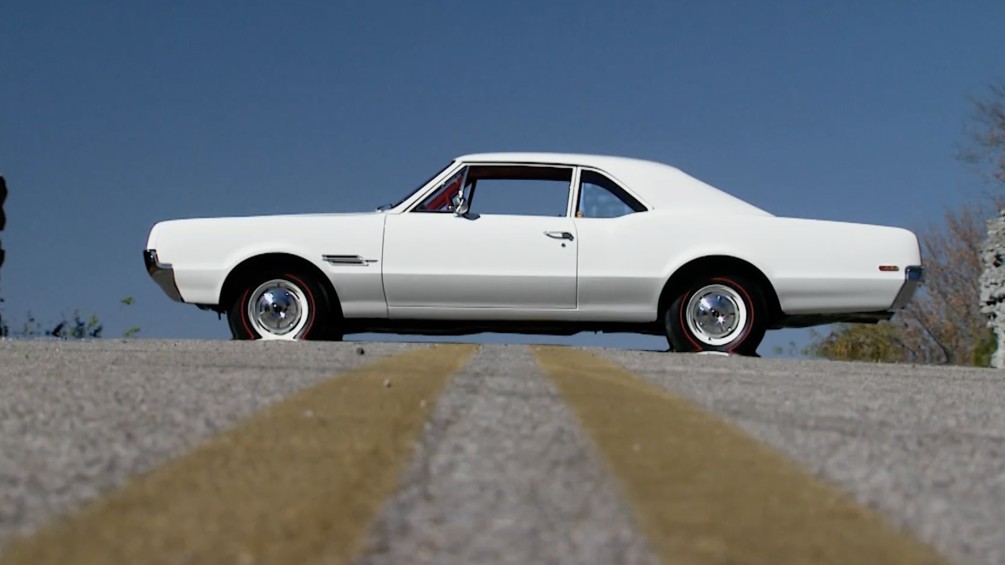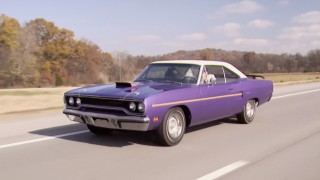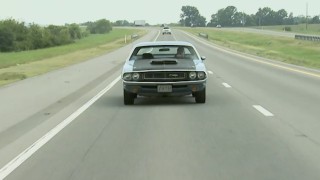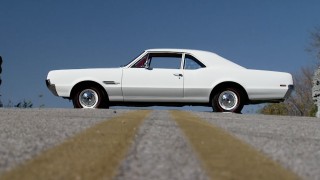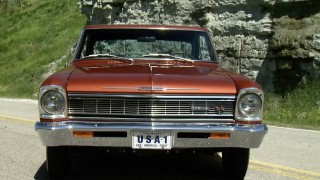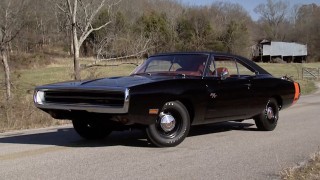Want more content like this?
Join the PowerNation Email NewsletterVideo Transcript
(Music)
( )>> A lot of people that see the car at a show or see it on the street think it's just a plain vanilla 4-4-2. They don't really know what lurks underneath the hood.
(Tommy)>> That's cause this '66 4-4-2 is equipped with the ultra rare ram-air package known as a W-30. Only 54 got the factory race setup that year. This is number 10.
(Joel)>> Your only clues from the outside are the scoops inside the front bumper. Looking like some crazy two headed shop vac, the scoops fed air through tubes directly into the air cleaner. The battery even had to moved to the trunk because the tubes got in the way.
(Tommy)>> As if that wasn't wild enough it's also outfitted with a one year only tri-carb system called the L-69. Utilizing the progressive mechanical linkage it eliminates the lag time of the outer two carb opening, which was common with vacuum assisted setups found on the GTO.
(Joel)>> The powerhouse of the W-30 was a specifically tuned 400 cubic inch V-8 with a hotter cam and high tension valve springs. In order to keep the exhaust heat out of the car there was as heat riser shut off valve on the intake.
(Tommy)>> The engine was blue printed on the bottom end with looser tolerances designed for drag racing. Rated at 360 horsepower, it likely generated north of 400.
(Joel)>> Boxed lower control arms, front and rear stabilizer bars, and stiffer springs gave the 4-4-2s a reputation as one of the best handling muscle cars ever.
(Tommy)>> The rest of the car is bare bones, built on the low level F-85 body style. It's got dog dish hub caps and a bench seat. To save weight there's no heater or radio.
(Joel)>> The only option available was the rocket rally pack gauges, which they made round instead of horizontal. The mandatory Hurst four speed pulled a set of 4.11 gears and it all rolled on skinny seven and a half by 14 red line tires.
(Tommy)>> The '66 models look pretty much like the '65s, except they got a hump in the rear quarters and fender vents behind the front tires. 4-4-2s had a unique mesh grille and taillight treatment.
(Joel)>> Introduced in '64 to compete with the GTO, the numbers originally meant four barrel, four on the floor, and two exhaust pipes. That kept changing as they added automatics and multi-carb setups. With that tri-carb it should have been called the 6-4-2.
(Tommy)>> The W-30 option wasn't advertised in '66. It wasn't even in the Olds brochure. So most folks still don't know it was offered that year. It was mainly targeted at racers as part of a win on Sunday, sell on Monday strategy.
(Joel)>> Well it worked. The Brainbeau Olds took the C-stock title in '66,and Olds sold almost 22,000 4-4-2s that year.
(Tommy)>> It doesn't matter how rare this car is. It was made to run hard, making 12 second quarters in stock condition. With performance like you'll wish this was your daddy's Oldsmobile.
Show Full Transcript
( )>> A lot of people that see the car at a show or see it on the street think it's just a plain vanilla 4-4-2. They don't really know what lurks underneath the hood.
(Tommy)>> That's cause this '66 4-4-2 is equipped with the ultra rare ram-air package known as a W-30. Only 54 got the factory race setup that year. This is number 10.
(Joel)>> Your only clues from the outside are the scoops inside the front bumper. Looking like some crazy two headed shop vac, the scoops fed air through tubes directly into the air cleaner. The battery even had to moved to the trunk because the tubes got in the way.
(Tommy)>> As if that wasn't wild enough it's also outfitted with a one year only tri-carb system called the L-69. Utilizing the progressive mechanical linkage it eliminates the lag time of the outer two carb opening, which was common with vacuum assisted setups found on the GTO.
(Joel)>> The powerhouse of the W-30 was a specifically tuned 400 cubic inch V-8 with a hotter cam and high tension valve springs. In order to keep the exhaust heat out of the car there was as heat riser shut off valve on the intake.
(Tommy)>> The engine was blue printed on the bottom end with looser tolerances designed for drag racing. Rated at 360 horsepower, it likely generated north of 400.
(Joel)>> Boxed lower control arms, front and rear stabilizer bars, and stiffer springs gave the 4-4-2s a reputation as one of the best handling muscle cars ever.
(Tommy)>> The rest of the car is bare bones, built on the low level F-85 body style. It's got dog dish hub caps and a bench seat. To save weight there's no heater or radio.
(Joel)>> The only option available was the rocket rally pack gauges, which they made round instead of horizontal. The mandatory Hurst four speed pulled a set of 4.11 gears and it all rolled on skinny seven and a half by 14 red line tires.
(Tommy)>> The '66 models look pretty much like the '65s, except they got a hump in the rear quarters and fender vents behind the front tires. 4-4-2s had a unique mesh grille and taillight treatment.
(Joel)>> Introduced in '64 to compete with the GTO, the numbers originally meant four barrel, four on the floor, and two exhaust pipes. That kept changing as they added automatics and multi-carb setups. With that tri-carb it should have been called the 6-4-2.
(Tommy)>> The W-30 option wasn't advertised in '66. It wasn't even in the Olds brochure. So most folks still don't know it was offered that year. It was mainly targeted at racers as part of a win on Sunday, sell on Monday strategy.
(Joel)>> Well it worked. The Brainbeau Olds took the C-stock title in '66,and Olds sold almost 22,000 4-4-2s that year.
(Tommy)>> It doesn't matter how rare this car is. It was made to run hard, making 12 second quarters in stock condition. With performance like you'll wish this was your daddy's Oldsmobile.
